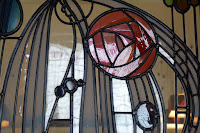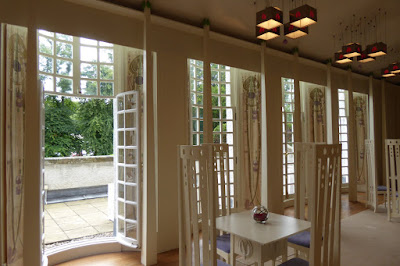Are, for instance, visitors to the Sistine Chapel, swooning at the experience, really reacting to the compositional brilliance of Michelangelo's frescoes, or are they reacting to their fame? Is the thrill that so many people have at looking up at that fabled ceiling, in truth, the thrill of proximity to something that is unique, of incalculable value and widely recognised as culturally significant, as opposed to a personal, aesthetic response to the actual artistry itself? Is part of the excitement of seeing the Mona Lisa in the Louvre all about the prior queing to get in, the anticipation, the required jostling of other tourists in the crowded room that houses it to get a decent view of that tiny, roped-off canvass?
It's hard to say, isn't it? But it is the sort of question that has troubled a lot of people ever since Walter Benjamin's musings on the 'cult value' of art objects - how they can, quite apart from their aesthetic merits, serve as focal points for ritual, spiritual experiences - and how this function is affected by the modern facility of their mass reproduction, in particular the invention of photography (ie his 1936 essay The Work of Art in the Age of Mechanical Reproduction).
In the 1970s, John Berger, in his influential TV series and accompanying book, Ways of Seeing, took this idea and added a cynical twist that made the question even more pressing. Berger argued, pretty convincingly, that the immense importance that people - both private collectors and public galleries (and their visitors) - place on the authenticity of oil paintings and other art works can only really be explained, given the ease with which the actual image can be reproduced and disseminated, as a kind of pseudo-spiritual response to the market value of the object itself.
On this view, one is humbled by the work's enormous price tag (or its being 'priceless'). The original painting is (to a greater or lesser extent) not really any more beautiful - certainly no more insightful or interesting - than a copy, but it is more unique, by virtue of being the original, and this uniqueness gives it scarcity (and hence market) value that that the copy lacks. An art work's cult value, in the end, becomes its market value:
On this view, one is humbled by the work's enormous price tag (or its being 'priceless'). The original painting is (to a greater or lesser extent) not really any more beautiful - certainly no more insightful or interesting - than a copy, but it is more unique, by virtue of being the original, and this uniqueness gives it scarcity (and hence market) value that that the copy lacks. An art work's cult value, in the end, becomes its market value:
'The bogus religiosity which now surrounds original works of art, and which is ultimately dependent upon their market value, has become the substitute for what paintings lost when the camera made them reproducible. Its function is nostalgic. it is the final empty claim for the continuing values of an oligarchic, undemocratic culture. If the image is no longer unique and exclusive, the art object, the thing, must be made mysteriously so.' (John Berger, Ways of Seeing, BBC/Penguin, 1972, page 23)Whoops, society! Oh dear, the art world! What could be more awful, more philistine, than going weak at the knees at the symbolic representation, in effect, of a huge pile of cash?
But even if you don't want to follow Berger in all his cynicism (and I'm not sure I do: isn't it really the social, cultural importance of the tangible object - its 'ritual value' rather than its monetary value that we are investing with spiritual awe?), I think you have to admit there is at least a tension between appreciation of the iconic status of an art work and appreciation of its inherent qualities. There's nothing wrong with being awed by the cultural significance of the Mona Lisa, or the Seagram Building, say - but it's not quite the same thing as assessing, with one's own eyes, the artistry involved in these things. Importance is not, arguably, quite the same as artistic merit.
So perhaps the best way of viewing a painting is, actually, at least in the first instance, to look at a print or indeed an image online. That way, the cult value of the art object is, perhaps, less likely to interfere with your appraisal and appreciation of the painting for its beauty (or otherwise) as a painting. Such an approach seems less than ideal, though, in the case of architecture: you really want to be able to walk around / inside a building to get the true measure of it.
Suppose, though, you could visit a thoroughgoing, detailed replica of a famously beautiful building. That would make for a nice scientific control, wouldn't it? If your spine tingled as you walked though it, you would know that the architect - qua designer rather than qua iconic figure - was truly onto something.
This is almost what I was able to do, recently, in Glasgow. For I visited the House for an Art Lover, a design by Charles Rennie Mackintosh, with interior details supplied by his wife Margaret McDonald, of 1901, constructed between 1989 and 1996, some 60 years' ago after those two famous Glaswegians' respective deaths.
This is almost what I was able to do, recently, in Glasgow. For I visited the House for an Art Lover, a design by Charles Rennie Mackintosh, with interior details supplied by his wife Margaret McDonald, of 1901, constructed between 1989 and 1996, some 60 years' ago after those two famous Glaswegians' respective deaths.
Strictly speaking, the building is not a replica, not a reconstruction, but an original construction. The designs for the house were produced for a German magazine competition, and although they helped launch Mackintosh's reputation on the continent, they were never built during his lifetime. The modern, 1990s building was the brainchild of a civil engineer, Graham Roxburgh, who managed the improbable feat of convincing the city council to support a scheme to build Mackintosh's house in a municipal park. A team from the Glasgow School of Art worked to reconstruct the interior from the rather patchy (and sometimes inconsistent) indications given in the drawings Mackintosh supplied to the magazine all those years ago - making educated guesses and sometimes outright inventions (for example, in one particular room there is nothing but the walls in the plan to go on) but always guided by the hints provided by Mackintosh and McDonald's wider ouevre and a careful consideration of the techniques and materials available at the time of the original design.
Well, I can report that, despite that its recency, despite it not being an authentic historical object, the House of an Art Lover is an inspiring place. It is beautiful, and fascinating, throughout.
If anything, the fact that so much of the detailing is guesswork - if painstakingly careful guesswork - on the part of present-day experts, as opposed to historical artefact, actually contributes to the fascination. Take, for example, the fabric banners that adorn the casing of the windows in the Music Room. All the designer had to go on here was an incidental detail of a perspective drawing of the room by Mackintosh: really no more than a tiny smudge indicating an elongated female form. The information boards explain how the designer experimented with blowing up this smudge to a full scale image, which didn't, in the event, provide a usable guide, before coming with an original interpretation based on a close study of the kind of lines and colours used in other Mackintosh/McDonald designs.
The result is not, therefore, an authentic historical record, but it is no less interesting - no less beautiful - for that. The team have had to come up with creative interpretations like this throughout the whole house, so scanty is the information provided by the original set of drawings. I think this approach is quite heroic in its own way: simultaneously brave and scholarly (two adjectives that don't usually sit together in the same sentence).
The other great advantage is that there are no rope barriers, no signs, even, telling you not to touch the (reproduction) furniture. Nor are there attendants hovering around the rooms watching you like a hawk. This gives the visitor a far, far greater sense of freedom than at the average historic attraction. Indeed, this makes the experience actually rather more immersive than is usually the case with this sort of thing: you can even sit down at the piano whose fantastical housing is the focal point of the Music Room and start playing, as one guy did when I was there.
You really do, in other words, feel transported right into the heart of Charles and Margaret's vision. That this vision appears such an affecting one in material reality, even when shorn of the social-psychological charge of historical authenticity, does rather argue for their genius as designers.
You really do, in other words, feel transported right into the heart of Charles and Margaret's vision. That this vision appears such an affecting one in material reality, even when shorn of the social-psychological charge of historical authenticity, does rather argue for their genius as designers.
















